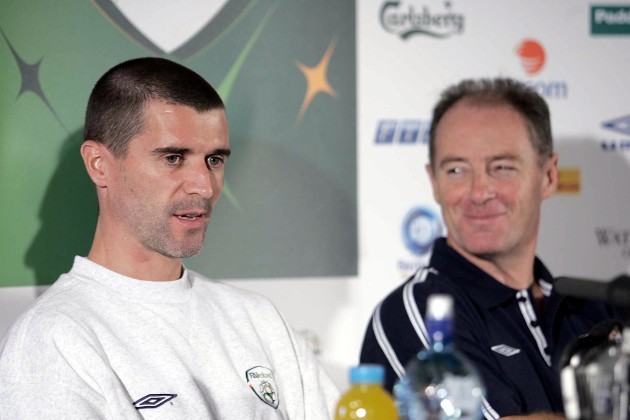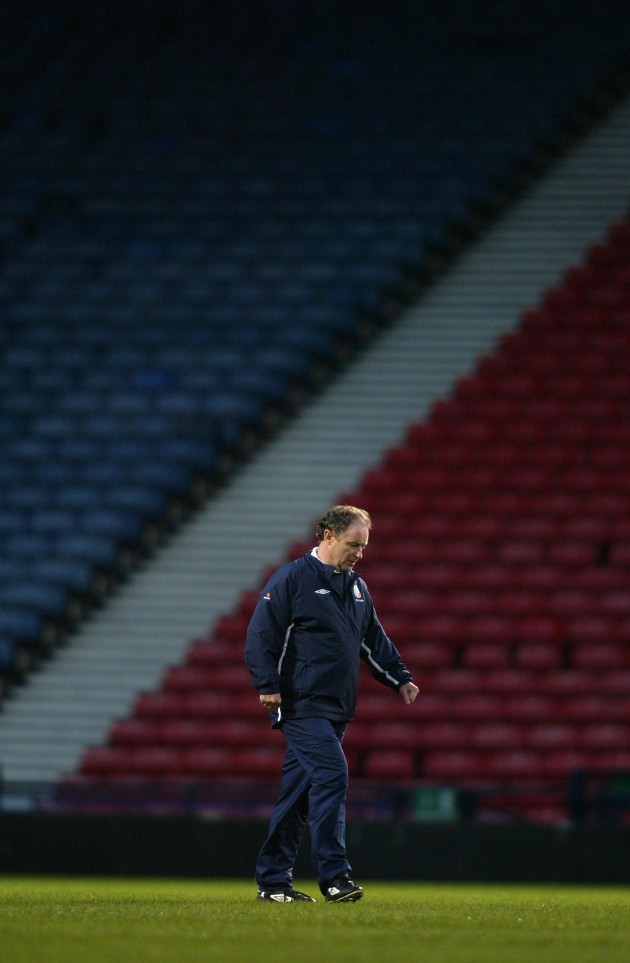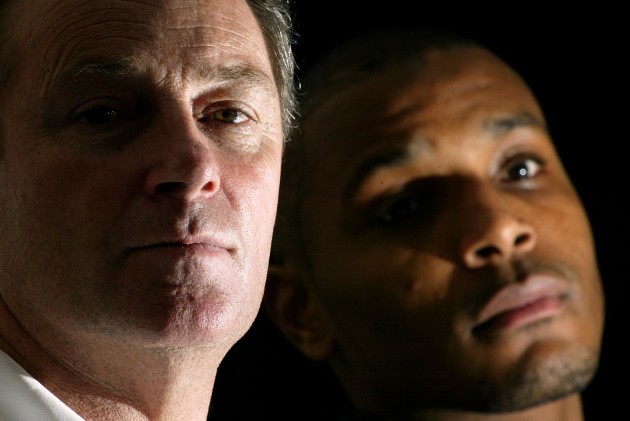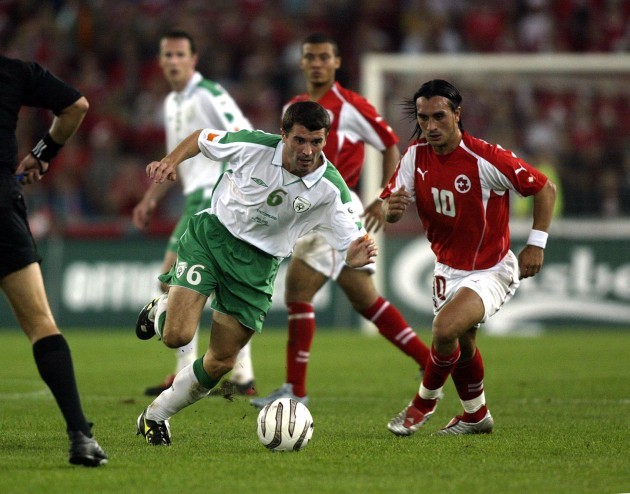For over 20 years, Garry Doyle has covered the Irish football team across the world, and each day this week, The42 will take you inside the dressing room as we retrace the biggest stories of the first two decades. Today Brian Kerr gives the inside track on getting Roy Keane back for Ireland.
ROY KEANE WAS in the car ahead. They’d been following him for nearly half an hour, Brian Kerr and his driver, keeping track through the crawl, crawl, crawl, of Manchester’s outer ring before things got a little tricky when they turned off a sliproad.
Here the traffic was noticeably lighter, the houses widely spaced, trees and gardens providing a kinder backdrop. The original plan, to meet in a hotel near the airport, had been scuppered when Kerr recognised a couple of soccer correspondents sitting in the lobby.
Instantly he backed away before the reporters spotted him, getting his mobile out to call Michael Kennedy, Keane’s solicitor. A fresh plan was hastily made, Keane suggesting this quiet out-of-town hotel Manchester United used for overnight stays as a more suitable spot.
This was 5 February 2003, eight months on since Saipan, three months since Mick McCarthy’s resignation. The race to succeed him had been a tedious, drawn-out process; Bryan Hamilton engaged to draw up a shortlist before a five-man committee quizzed the respective candidates: Kerr, Kevin Moran, John Aldridge, Bryan Robson, Phillipe Troussier.
“Roy coming back was the big issue in the succession race,” Kerr recalls. “Bryan brought it up in our initial meeting; the press brought it up every day of the week. The interview panel asked me about it, too. I told them I was going to go about it my own way.”
Hence why he was here, telling his driver, Eamon McLoughlin, to hang a right rather than a left, as they turned onto this quiet country road.
The night before, Kerr had invited three confidants to his house; Noel O’Reilly, his assistant and trusted friend; Liam Moggan, a psychologist who Kerr was close to; Packie Bonner, the Irish goalkeeping coach whose training ground row with Keane in Saipan provided one of the enduring images of that long, hot week.
Over tea and biscuits in his front room, he told them how he planned to go about the following day’s meeting, asking for their feedback, teasing out the ideas in his head. And all this was going through his mind the following day as McLoughlin swayed to avoid a pothole and keep in touch with the car in front.
All of a sudden, Keane’s indicator was on, his driver taking him into a driveway where they promptly turned and headed back in the direction they’d come from. The hotel was on the same road, half-hidden among the trees and bushes, McLoughlin forced into a clever piece of manoeuvring to keep Keane within sight.
Eventually, they got there, through the gates, into the car park, the Manchester drizzle splattering across their windscreens. Keane was out of the car first before Kerr walked across to greet him, his hand extended. “You did well there,” Kerr joked. “You nearly shook me off.”
It was the first time Keane had spoken face-to-face with an Ireland manager since Saipan.
**
The sharp piece of reversing wasn’t the only U-turn Keane would do that week. His meeting with Kerr lasted just under three hours; the pair making an instant connection, talking for a while about boxing, the sport Kerr’s father was a six-time national champion in, one Keane also mentioned in his autobiography.
Prior to meeting Keane, Kerr had already been in touch with some of Keane’s old sparring partners – Kenny Cunningham, Matt Holland, Shay Given and Jason McAteer – to tell them of his intention to get Keane back. “What had happened in the past was of no issue to me,” Kerr tells The42.
“As far as I was concerned, we were starting from a clean slate and while I knew some of the players may have had some deep opinions on the matter, I’d an obligation to put the best team available out on the pitch.”
Suddenly it looked like Keane would be one of those men. “It was a long and deep conversation,” Kerr says. “We talked about my style of management and how it was for everyone’s good, the team, Roy, his family, the country, that he came back. Put it this way, by the end of the meeting, I felt comfortable that he was going to be in Scotland the following Sunday to prepare for my opening game at Hampden Park.”
No such luck.
Thursday was when the reunion plans started to unravel. Keane had a meeting that day with United’s medical people who were conscious of his problematic hip, advising him to be sparing in the number of matches he played.
On Friday, he called Kerr. Hope had turned to uncertainty. Within minutes, Alex Ferguson was also on the phone to Kerr, saying there was no way Keane would be able to play the following week’s friendly in Scotland. “We had a reasonable discussion, Alex wishing me well in the job although I could tell he wasn’t overly pleased that Keane’s workload might potentially increase.” By Monday, Keane had phoned again, expressing doubts about coming back.
Suddenly it was Tuesday, Kerr 24 hours away from the opening game of his tenure. John Fallon, the kit-man, approached him. “You better take this call,” Fallon said.
“I knew by the face on him that it was serious,” Kerr said.
His hunch was right. Fintan Drury, his agent, was on the line, telling him that Keane had released a statement to Tommy Gorman, confirming he was about to retire from international football.
“I went straight back to the training session, finished it off, gathered the players in the changing room afterwards and said, ‘right, that’s it now. We all go from here’.”
**
This was their chance to strike a claim for independence because for years, it was loosely stated that an Irish team with Keane was different to one without him. Statistics backed up the hunch, Mick McCarthy’s Ireland winning over 51% of their games when Keane was on the pitch, 42% of them in his absence. Significantly, all the key victories of McCarthy’s reign – Croatia, Yugoslavia, Portugal and Iran – had Keane’s fingerprints all over them.
Now he was gone, a leadership vacuum remained, made all the worse first by Steve Staunton, Niall Quinn and Alan Kelly’s retirements from international football, later by the additional decisions of Dean Kiely and Gary Kelly to quit. Those left behind still managed to keep qualification hopes alive until the final day of that Euro 2004 campaign, but a 2-0 defeat in Switzerland, coming a month after Russia had clawed a 1-1 draw in Dublin, dashed their hopes.
Everyone, Kerr, the supporters, the players, hoped Keane would change his mind.
“My view was we needed better players (after the Euros campaign had ended),” says Kerr. “I wanted to get Roy back in the side to improve and develop it. I saw the team’s qualities, or lack of qualities, compared to the side we had in the second campaign.”
This 2004/05 Ireland team was better. Andy Reid had emerged, 2004 and 2005 being the best years of his career; Clinton Morrison got free from injury and took his chance, scoring crucial goals against Cyprus, Switzerland and Israel. “When Brian came in,” Morrison said, “loads of people in England were saying to me, ‘who is he?’
Well, I’ll tell you who he is. Along with Mick McCarthy, he is one of the best managers I ever worked for. He pulled me aside when he first came in: ‘Clinton,’ he said, ‘you’re the man for me to go up alongside Robbie’. He filled me full of confidence. The next night I scored against Scotland. I thought he was great.”
Then there was Andy O’Brien. In 2004, he played 729 minutes of international football against Brazil, Poland, Romania, Jamaica, Holland, Cyprus, Switzerland, France and the Faroes. Ireland conceded one goal when O’Brien was on the park.
Trumping the Morrison and O’Brien success stories, though, was Keane’s.
I’d never given up on getting him back,” Kerr said. “The thought lingering in my head was that the whole Japan situation had ended so awfully and I felt it wasn’t the right way for his Ireland career to finish up. I’m sure people in his family thought the same.”
A chance meeting, in Croke Park of all places, was where the turnaround began. It was June 2003, Keane on stage for the opening ceremony of the Special Olympics, Kerr in the VIP lounge for a pre-arranged reception. Keane passed him, shook his hand, pausing for a brief chat. “You’ve a good chance of getting to the Euros,” he told him.
“Yeah but we’d have a much better chance if we had you back,” Kerr replied.
**
March 2004. The Park House office block, Dublin. Two pints of lager and a packet of salt ‘n vinegar crisps is playing havoc with your correspondent’s stomach. Two o’clock in the afternoon and not a word written nor the prospect of anything meaningful getting typed before the day’s out. That was about to change.
Two weeks previously Keane had appeared at a charity event promoting the work of guide dogs for the blind. He spoke cryptically that day about his desire to play for Ireland again, saying the ball was firmly in Kerr’s court. The Ireland manager was now about to return serve.
Your correspondent’s phone rings. “Call Brian,” the dramatist on the other line says. “Now.”
Kerr answers. “Everyone knows how to get in touch with me if they want to come back,” he says. “If Roy Keane wants to make himself available in the future then I have no problems with that. But ultimately I’ll be in charge.”
The Irish Mirror – my then employers – splashed the story on the front page. An extra 3,000 copies disappeared off the shelves that day.
**
The Good Friday Agreement is settled in Manchester. There is no car chase this time, no drama. Keane met Kerr in the Manchester house that McLoughlin – who worked for Kerr’s agent – was renting at the time. The deal was done within minutes. Two days later, Easter Sunday, Keane spoke to Ferguson. And that was it. The announcement was made the week after. Keane was back.
Or was he?
After playing against Romania in a friendly, a rib injury against Norwich looked set to keep him out of Ireland’s opening two World Cup qualifiers against Cyprus and Switzerland. “But I felt Roy really wanted to play in those games,” Kerr said. “I knew a lot of discussions were going on in the background between our medical staff and United’s but I didn’t want to announce anything until I saw him walk through the doors of the hotel.”
By Sunday, the day after a 3-0 win over Cyprus, Keane was sitting in the lobby drinking tea with Kerr. The pair set down to work. Switzerland were a decent team, underrated in Ireland largely because their players flew under the radar, more of them earning a living in the Bundesliga than the Premier League. Still, they’d won their two previous games against Ireland, Hakan Yakin the chief reason for their dominance.
“Look at this here,” Kerr said to Keane and Kevin Kilbane, his central midfield partner, as they stared at a dozen or so moments from previous Ireland/Switzerland matches on their manager’s labtop. “This is where he caused us problems the last time. One of you two needs to be around when he picks up these positions.”
Keane waited his moment and spoke to Kerr alone. “Look it, I’ll deal with yer man,” he said.
“I remember thinking great, this is exactly why I want this fella back,” Kerr says.
Ireland started well in Basel, Morrison opening the scoring. The Swiss then took over, Yakin equalising soon afterwards before he ran the game for 10 minutes. “Roy, in his enthusiasm to impose himself, pushed forward too much early on.”
At half-time, Kerr had his say. “We’ve got to be more disciplined in there,” he sternly told Keane and Kilbane. It was the first time the Cork-man has been rebuked by an Irish manager since Saipan. This time the Corkman didn’t say a word back.
“Look it, you’re always trying to get a balance between fixing the things that are going wrong and sending the team back out there with confidence,” Kerr says. “Sometimes you get discussions (between players and management) at half-time. That night we made our point. They listened. We were tactically tighter in the second-half. The least we deserved was a point.”
**
One thing that has been forgotten about that game is a first-half incident involving Keane and Murat Yakin, Hakan’s brother – when Murat did a convincing impersonation of John Travolta dancing with Uma Thurman in Pulp Fiction, grabbing Keane by the arm and swinging him around. It should have been a penalty. It ended up with Keane getting booked.
It was one of those little moments that didn’t go Ireland’s way in that 2006 World Cup campaign. There’d be more. Against France the following month, John O’Shea sent a shot inches wide from five yards as Ireland secured a credible 0-0 draw in Paris. At home to Israel in June, Ireland 2-0 up, Morrison had a goal disallowed for offside seconds before Robbie Keane had to go off with an injury. Roy Keane missed that 2-2 draw through suspension. That Yakin incident, that penalty that never was, that unjustified yellow card and subsequent suspension, all those little moments contributed to one big thing: Ireland narrowly losing out on the 2006 World Cup to France and Switzerland; Kerr wrongly losing his job.
“In your career, you need some things to break for you,” Kerr says. “As (Ireland’s) underage manager, I remember the Under 16 European championship final against Italy, getting away with a penalty decision in the last minute when we were 2-1 up. We got a lucky break with the Under 18s in Cyprus that summer, Croatia beating England to allow us qualify for the final, which we won on penalties.
“I can honestly say that I don’t think we got one result in that 2006 World Cup campaign that we didn’t deserve and I can remember, in our final game, at home to Switzerland, Shay Given holding the ball in his hands in stoppage time, saying to myself: ‘if there is any justice in this game, we’ll score here.”
There was no justice.
It was a sinking feeling to miss out on the 2006 World Cup,” Kerr said. “To this day, I still don’t think we had any luck. It’s still very frustrating.”
**
The feeling would get worse. Within a week of the Swiss draw, John Delaney called a press conference following a meeting of the FAI board. Kerr’s contract wasn’t going to be renewed.
“As early as June that year, I knew we’d need to get to the World Cup if I was going to get a new contract. But that just made me doubly determined to qualify. In fact, in my head I felt we could win the World Cup. I kind of thought, why not? We’d won underage competitions when no one gave us a chance. The players were good, the spirit was strong. When you get to a tournament and build momentum, things can happen.”
Instead the only thing happening to Kerr was a horrible Tuesday evening when he was told, via his agent, his job had gone. The FAI, meanwhile, promised to replace Kerr with ‘a world class manager’. His name was Steve Staunton.
- Chapter 4 tomorrow: the Staunton years.







